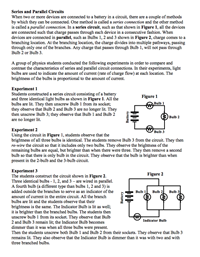 Circuits Comparision
Circuits Comparision
Resource:
The Science Reasoning Center: Series and Parallel Circuits
Grade Level: High School
Description:
This passage describes three simple experiments in which the characteristics of series and parallel circuits are compared and contrasted. Figures and written descriptions of observations are provided to describe how the arrangement of light bulbs affects the bulb brightness. Questions target a student's ability to understand an experimental design, to draw conclusions that are consistent with provided data, to make appropriate inferences based on observations, to identify simple relationships between variables, and to identify the experimental conditions that would lead to specific results.
This activity aligns with the three dimensions of the Next Generation Science Standards in the manner described below:
| Definitions of Energy (HS-PS3.A.4): Electrical energy may mean energy stored in a battery or energy transmitted by electric currents. |
Light bulbs convert electrical energy into light energy. For a given battery or voltage source, the rate at which this energy is transformed is related to the resistance offered by the bulbs and their configuration in the circuit. As this passage compares bulbs connected in series and parallel, students understand how these two circuit types are different in terms of basic electrical connections as well as in determining overall resistance. In addition, students will apply the concept that electric current is inversely related to resistance and explore how this impacts bulb brightness (and ultimately the rate at which electrical energy is converted to light). |
| Cause and Effect: Cause and effect relationships can be suggested and predicted for complex natural and human designed systems by examining what is known about smaller scale mechanisms within the system. |
After students examine the results of Experiments 1 and 2 (series circuits), they compare these results with observations made in Experiment 3 (parallel circuit). In the end, students understand the behavior of one, two, and three bulbs connected in series and how their brightness varies when compared to one, two, and three bulbs connected in parallel. Students appreciate that the number of bulbs AND their configuration (series or parallel) effects the overall brightness of the bulbs. |
| Planning and Carrying Out Investigations: Plan an investigation or test a design individually and collaboratively to produce data to serve as the basis for evidence in building/revising models, supporting explanations for phenomena, or testing solutions to problems. Consider possible confounding variables and ensure variables are controlled. |
While there is no substitute for students actually planning and carrying out real investigations, it is possible to assess skills related to this science and engineering practice through passages such as this one. Questions at the end of the passage can be used to target specific skills within this practice. Questions such as, “Which one of the following experimental conditions were essential for such an observation? Which statement most accurately describes the purpose of Experiment 2? What was the role of the Indicator Bulb in Experiment 3?” are examples of how this passage seeks to assess this important NGSS science and engineering practice. |
| Analyzing and Interpreting Data: Evaluate the impact of new data on a working explanation and/or model of a proposed process or system. |
About half of the questions at the close of this passage involve students analyzing and interpreting data and information presented. While data is often found in table and graphs, this passage requires to the reader to gather data and important information from within a body of text. This is also an important skill for scientist and engineers. As each subsequent experiments presents new findings, students must evaluate the impact of this new information in light what they have already learned. |
| Using Mathematical and Computational Thinking: Use mathematical representations of phenomena or design solutions to describe and/or support claims and/or explanations. |
Several of the end-of-passage questions ask students to think through the implications of the inverse relationship between resistance and flow rate of charge. In reality, this passage offers students many opportunities to use mathematical and computational thinking to support claims and to offer explanations for results recorded. |
Associated Reading from The Physics Classroom
Other Supporting Pages at The Physics Classroom:
View Infographic.
(Coming Soon)
Search the NGSS Corner
Maybe you're looking for something really specific that pertains to a desired topic and emphasizes one or more of the listed NGSS dimensions. Why not try a search of this section of our website? Simply select from one or more of the pull-down menus and click Search This page will reload and a collection of possibilities will be displayed in this section of the page and sorted by relevancy.